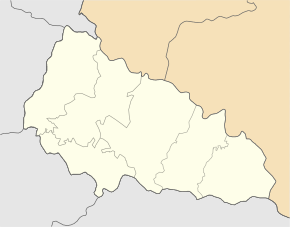Vynohradiv
| Vynohradiv | ||
| Виноградів | ||

|
|
|
| Basic data | ||
|---|---|---|
| Oblast : | Zakarpattia Oblast | |
| Rajon : | Vynohradiv district | |
| Height : | 136 m | |
| Area : | Information is missing | |
| Residents : | 25,383 (2004) | |
| Postcodes : | 90300 | |
| Area code : | +380 3143 | |
| Geographic location : | 48 ° 8 ' N , 23 ° 2' E | |
| KOATUU : | 2121210100 | |
| Administrative structure : | 1 city | |
| Mayor : | Stepan Botschkaj | |
| Address: | площа Миру 5 90300 м. Виноградів |
|
| Statistical information | ||
|
|
||
Vynohradiv (Ukrainian Виноградів ) is a city in western Ukraine , Zakarpattia Oblast , in the plain of the Tisza River .
The city is located in Carpathian Ukraine on the border with Romania and Hungary and is the administrative center of the Rajons Wynohradiv .
In 2004 the city had 25,200 inhabitants, around 15% of whom are Hungarian.
City name and languages
Due to the multiplicity of ethnic groups who lived through the centuries in Vynohradiv and live, there are different linguistic designations for the city name: Rusyn Севлюш / u Sevljuše or Сивлюш / Sywljusch , Russian Виноградов / Vinogradov , Hungarian Nagyszőllős (not to be confused with the Romanian Seleus , formerly Nagyszőllős ), Slovak (Veľký) Sevľuš / Vinohradov , Czech (Velká / Velký) Sevl (j) uS / Vinohradov , polish Vinogradov , latin Szeuleus , yiddish Sejlesch or Söjlesch , Romanian Seleuşu Mare (not to be confused with the Romanian Seleuš , formerly Seleușul Mare ).
history
Vynohradiv shares the history of Carpathian Ukraine . The place was first mentioned as Zceuleus in 1262 when it received its town charter from the king . He is one of the oldest in Ugocsa County and is mentioned on a royal bill.
In 1329 the city was granted economic and commercial rights by King Charles I and from then until 1919 it was the capital of the Hungarian Ugocsa County . Its Hungarian name Nagyszőlős comes from the word szőlő for grapes , as the place was an important wine landscape .
In 1717 there was a Tatar invasion in which almost the entire population was killed or expelled. In 1880 the city, which was part of the Hungarian half of the Empire in the Austro-Hungarian Empire , already had 4,400 inhabitants, in 1881 a public civic school was opened.
In 1910 the city had 7,811 inhabitants, of which 5,943 or 76% claimed to be Hungarian , 1,266 or 16% to be Russian and 540 or 7% to be German . 3,311 or 42.5% were members of the Greek Catholic Church, 2,237 or 28.6% were Jewish and 1,124 or 14.4% were Calvinists.
After the end of the First World War it became part of Czechoslovakia in 1919 , and Transcarpathia was annexed by Hungary in 1939. After the occupation by the Germans in 1944, the Jewish ghetto was set up as a collection camp for all Jews from northern Transcarpathia, with most of them being taken to Auschwitz from May to June 1944 , where they were gassed shortly after arrival. The Jews usually spent two weeks in the Jewish assembly camp before they came to Auschwitz.
In 1944, when the city was captured by Soviet troops , around 4,000 male civilians were deported to the Soviet Union , 70% of whom perished in captivity. The place was added to the Ukrainian SSR and was initially called Sevljusch (Севлюш), but was renamed in 1946 based on the Hungarian name (Szőlős = "vineyard") in Winogradow (= "Weinstadt / Weinburg").
Personalities
- Ábel Szocska (* 1972), bishop of the Hungarian Greek Catholic eparchy Nyíregyháza , was born in 1972 in Wynohradiw.
literature
- Nagyszőllős , in: Guy Miron (Ed.): The Yad Vashem encyclopedia of the ghettos during the Holocaust . Jerusalem: Yad Vashem, 2009 ISBN 978-965-308-345-5 , pp. 515f.


